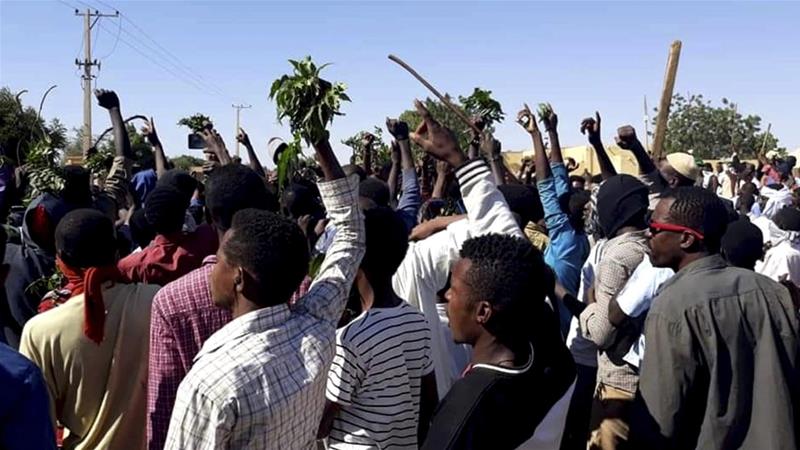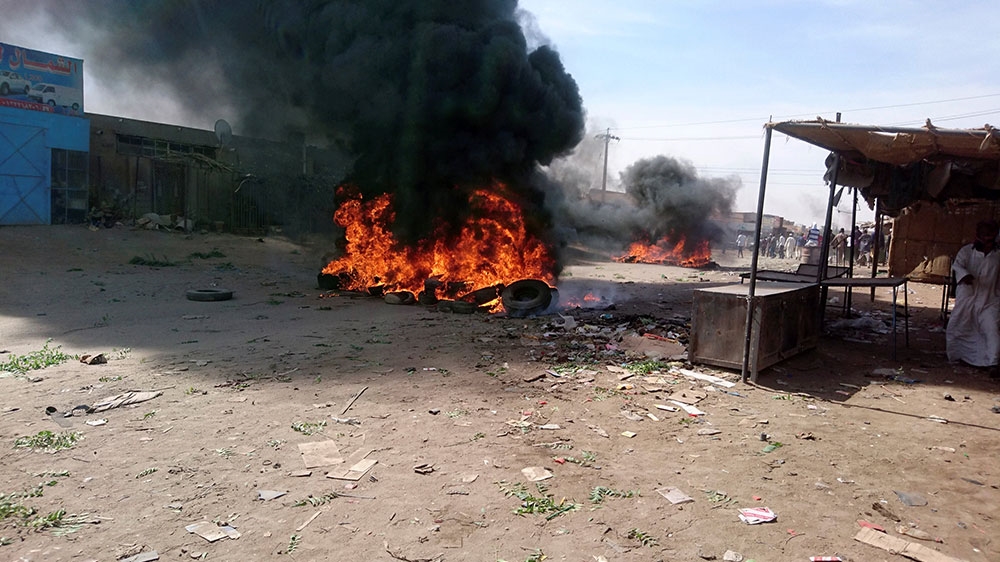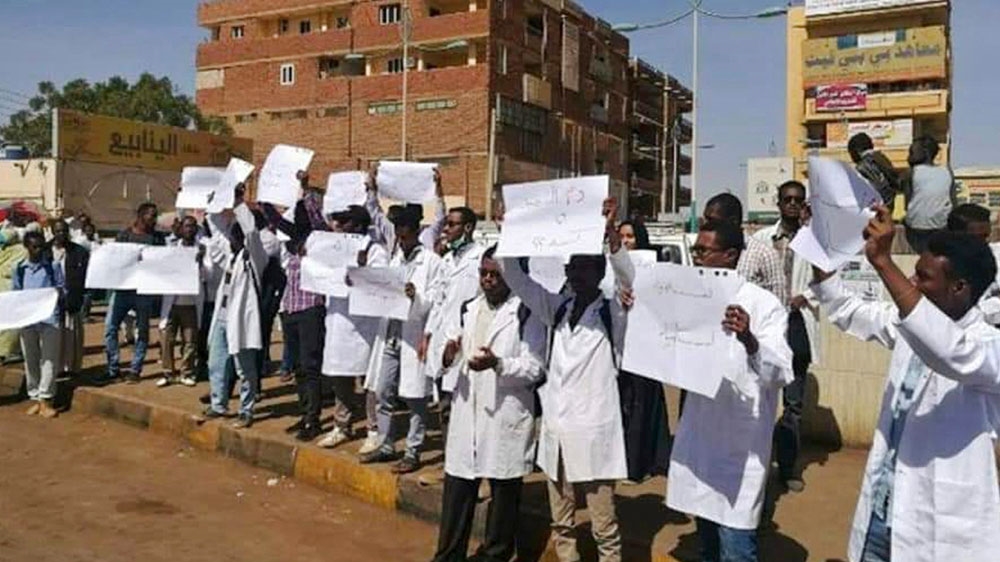Home » Middle East »
What prompted the protests in Sudan?
Protests that started over the rising costs of bread and fuel have now widened with calls for the overthrow of al-Bashir
Sudan at a glance
– US lifted 20 year trade sanctions in October 2017
– Sudan split from South Sudan in 2011, losing three-quarters of its oil output
– President al-Bashir has been in power since 1989
Monday marks the sixth day of anti-government protests in Sudan.
The protests started over the rising costs of bread and fuel, but have since widened to call for the overthrow of President Omar al-Bashir.
In less than a week, the demonstrations which began on December 19 in the city of Atbara quickly spread across the country, including to the capital Khartoum.
In some cities, security forces have used tear gas on protesters and witnesses report the use of batons and live ammunition by riot police. Protesters have attempted to storm official building and set fire to tyres in the streets.
At least 12 people have been killed, according to official estimates. Opposition groups say the death toll is higher.
Sudanese have reported limited internet access and have accused the government of blocking social media platforms, allegations officials deny.
Officials blame the protests on “infiltrators”. On Sunday, Sudan’s official news agency SUNA reported that authorities had arrested a “cell of saboteurs”, which had planned “acts of vandalism in the capital”.
Amnesty International called for the immediate release of those arrested, and for the government to restore the internet and “respect the people’s right to information”.
In his first public comments since the protests began, al-Bashir warned citizens on Monday against responding to “attempts to instil frustration”, according to SUNA, which also reported that the president and security aides had met. Bashir was quoted as saying the government was “continuing with economic reforms that provide citizens with a decent life”.
As the protests are set to continue, Al Jazeera breaks down what triggered them and what is expected to happen next:
Why are people protesting?
The main trigger for the recent protests was the government’s decision to increase the price of a loaf of bread from one Sudanese pound to three (about $0.02 to $0.06).
But anger has been boiling across Sudan, with some describing it as a “ticking time bomb”, over the rising costs and other economic hardships, including soaring inflation and limits on bank withdrawals.
“There is no cash at the ATM machines most of the time. Banks keep sending people away with only 500 SDG [about $10.50 at the official exchange rate] in their pockets, which is barely enough for a day,” said 29-year-old Yusuf Elhag, who has been protesting in Khartoum.
In 2011, South Sudan seceded from Sudan, taking most of the oil fields that its now northern neighbour relied on to boost its economy.
Although the United States lifted its 20-year-old trade sanctions on Sudan in October 2017, the country has been unable to recover from losing three-quarters of its oil output.
“Many had expected the lifting of US sanctions in October 2017 would invite foreign investment and bring about an improvement in the economy, but the opposite has happened, for multiple reasons,” said Isma’il Kushkush, an independent journalist who reported for eight years from Sudan and East Africa.
According to Kushkush, the Sudanese people have become angry over the Central Bank’s decision to devalue the pound. Inflation also rose by nearly 70 percent, he said.
But what started as an economic protest has now turned political, with many calling for the end to al-Bashir’s rule.
“Protests that started against high bread price have become calls of ‘the people want to bring down the regime’,” Kushkush told Al Jazeera.
Many have also pointed to what they call widespread corruption within the government.
A long history of protests
The Sudanese people have been fighting for a better quality of life for decades.
The country gained its independence in 1956. Two years later, Ibrahim Abboud took power in a military coup that forced out the elected civilian government.
During Abboud’s rule, Sudan’s economy suffered, leading to widespread discontent.
On October 21, 1964, police stormed a meeting of Khartoum University’s Student Union whose members were discussing the political situation. Mass protests and strikes ensued in what became referred to as Sudan’s October Revolution. Abboud was forced out.
In the years that followed, Sudan experienced a series of coups and conflicts.
In 1989, al-Bashir took power in a coup while the country was experiencing a civil war. The war officially ended in 2005, but other conflicts broke out, including in Darfur. The International Criminal Court has issued two arrest warrants for al-Bashir, accusing him of a number of war crimes, genocide and other grave human rights abuses allegedly committed in the country’s western region.
In 2013, hundreds protested against the rising costs of fuel and cooking gas. The government used force to crack down on the demonstrations. Multiple people were arrested and, according to rights groups, more than 200 people were killed.
In 2016, life came to a virtual standstill on the streets of Khartoum when citizens took part in several days of civil disobedience, with many staying home from work, universities and schools. The strike was in response to a dramatic increase in the price of medication, fuel and electricity.
Protests continue to spread
The current wave of protests is taking place in multiple cities across Sudan, including in Khartoum, Atabara, Um Rawaba and Gadarif.
States of emergency and curfews have been declared in several of the protesting cities.
In a viral video sending a message “from Sudan to the world” posted by Elhag, he said, “People are protesting in north Sudan in the city of Atbara where it all started and broke out and also in east Sudan in the city of al-Gadarif and in west Sudan in the city of El Obeid in the state of Kordofan. The capital Khartoum is facing mass protests in different areas.”
Kushkush added that the protests by high school students in the northern town of Atbara is what caught national attention. People of all ages are taking part in the demonstrations.
In Khartoum, Elhag told Al Jazeera that the average age of protesters has been around 17 to 23 years old.
What’s expected next?
On Monday, doctors part of the independent Central Doctors’ Committed, which is affiliated with the independent Sudanese Professionals’ Association, began a nationwide strike.
According to the Associated Press, the coalition said the doctors will continue to respond to emergencies during the strike. The coalition also said the work stoppage aims to “paralyse” the government, denying it much-needed revenue.
Strikes among other professions are also expected to begin this week.
According to AFP news agency, the ruling National Congress Party said it understands the protesters concerns, but a spokesman for the party also blamed the unrest on Israel and “left-wing parties that hope to destabilise the state”.
On Sunday SUNA quoted a military statement that read, “The armed forces asserts that it stands behind its leadership and its keen interest in safeguarding the people’s achievements and the nation’s security, safety along with its blood, honour and assets”.
Kushkush said he would be surprised if the government cracked down on protesters as it did in 2013 when more than 200 people were killed.
Ultimately, he said, the outcome of the protests will be “shaped by how protesters, opposition activists organise, what actions the government and its allies take, and how the global community reacts. Protests and uprisings have a logic of their own.”
The people of Sudan are simply “asking for a better lifestyle, better human rights and a better life,” Elhag added.
Source: Read Full Article





